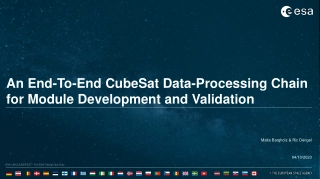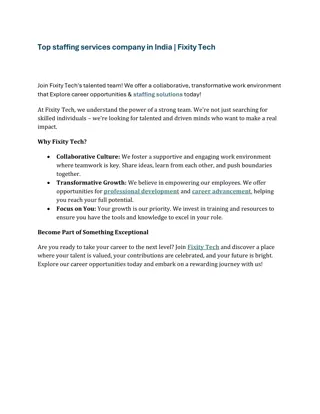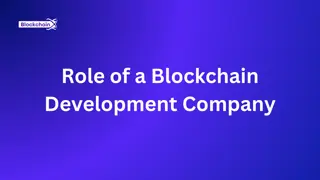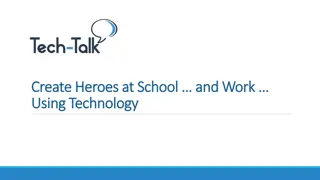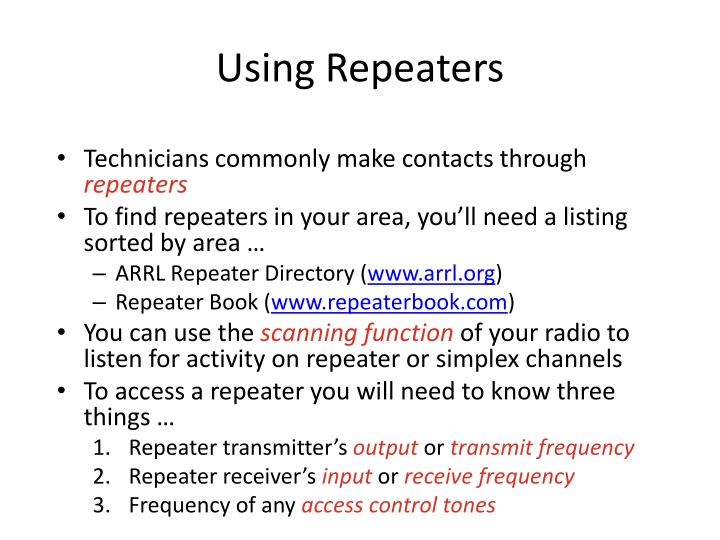
Repeater Operations and Access in Ham Radio
Learn how to effectively use repeaters in ham radio communication, including accessing repeaters, understanding offsets, linked repeater systems, access tones, and troubleshooting. Practice questions help reinforce key concepts.
Download Presentation

Please find below an Image/Link to download the presentation.
The content on the website is provided AS IS for your information and personal use only. It may not be sold, licensed, or shared on other websites without obtaining consent from the author. If you encounter any issues during the download, it is possible that the publisher has removed the file from their server.
You are allowed to download the files provided on this website for personal or commercial use, subject to the condition that they are used lawfully. All files are the property of their respective owners.
The content on the website is provided AS IS for your information and personal use only. It may not be sold, licensed, or shared on other websites without obtaining consent from the author.
E N D
Presentation Transcript
Using Repeaters Technicians commonly make contacts through repeaters To find repeaters in your area, you ll need a listing sorted by area ARRL Repeater Directory (www.arrl.org) Repeater Book (www.repeaterbook.com) You can use the scanning function of your radio to listen for activity on repeater or simplex channels To access a repeater you will need to know three things 1. Repeater transmitter s output or transmit frequency 2. Repeater receiver s input or receive frequency 3. Frequency of any access control tones
Repeater Offset (Shift) To listen to a repeater, tune to its output frequency To send a signal through the repeater, you must transmit on the repeater s input frequency The difference between repeater input and output frequencies is called the repeater s offset or shift For 2 meters, usually 600 kHz For 70 centimeters, usually 5 MHz
Linked Repeater Systems & Access Tones To extend their range, repeaters sometimes use remote receivers Repeaters can also be linked to other repeaters (by sharing the signals each receives and retransmitting them) Most repeaters won t pass a signal from the receiver to the transmitter for retransmission unless it contains an access tone Also called Continuous Tone Coded Squelch System (CTCSS), PL (for Private Line, the Motorola trade name) or sub-audible Your radio s operating manual will explain how to select and activate the tone There may be several tone options, such as tone squelch and digital code squelch (DCS) Troubleshooting repeaters If you can hear a repeater s signal, but it can t hear you Make you re sure you are using the right offset Make sure you have your radio set up to use the right type or frequency of access tone (CTCSS) Make sure your radio s digital code squelch settings are correct (DCS)
What does the scanning function of an FM transceiver do? A. Checks incoming signal deviation B. Prevents interference to nearby repeaters C. Tunes through a range of frequencies to check for activity D. Checks for messages left on a digital bulletin board T4B05 C 6-10
What is a common repeater frequency offset in the 2 meter band? A. Plus or minus 5 MHz B. Plus or minus 600 kHz C. Plus or minus 500 kHz D. Plus or minus 1 MHz T2A01 B 6-11
What is a common repeater frequency offset in the 70 cm band? A. Plus or minus 5 MHz B. Plus or minus 600 kHz C. Plus or minus 500 kHz D. Plus or minus 1 MHz T2A03 A 6-11
What is meant by repeater offset? A. The difference between a repeater s transmit and receive frequencies B. The repeater has a time delay to prevent interference C. The repeater station identification is done on a separate frequency D. The number of simultaneous transmit frequencies used by a repeater T2A07 A 6-11
Which of the following describes a linked repeater network? A. A network of repeaters in which signals received by one repeater are transmitted by all the repeaters in the network B. A single repeater with more than one receiver C. Multiple repeaters with the same control operator D. A system of repeaters linked by APRS T2B03 A 6-12
What term describes the use of a sub-audible tone transmitted along with normal voice audio to open the squelch of a receiver? A. Carrier squelch B. Tone burst C. DTMF D. CTCSS T2B02 D 6-12
Which of the following could be the reason you are unable to access a repeater whose output you can hear? A. Improper transceiver offset B. You are using the wrong CTCSS tone C. You are using the wrong DCS code D. All these choices are correct T2B04 D 6-12
Digital Repeater Systems Ham radio and the Internet can link repeaters and communicate nearly anywhere on Earth some of these systems include: IRLP (Internet Radio Linking Project) EchoLink WIRES II a proprietary system of the Yaesu company D-STAR a system based on the public D-STAR standard DMR Digital Mobile Radio
Digital Repeater Systems (cont.) IRLP and EchoLink contacts differ from a regular repeater contacts initiating station must know the repeater control code to request an IRLP connection a sequence of DTMF or Dual-tone Multi-Frequency tones WIRES II uses voice-only standard developed by radio manufacturer Yaesu D-STAR combines digital voice and data communications DMR is a technique for time-multiplexing two digital voice signals on a single 12.5 kHz repeater
Digital Repeater Systems (cont.) You don t need different radios for each digital voice system hot spots are used that link your digital transceiver to the internet, and software in the hot spot makes the connection WIRES II/System Fusion, D-STAR, DMR, P25, and NXDN all use talk groups in one form or another To join a talk group, you ll need to know the group s identification code or number You ll also have to enter your own identification code (and call sign for D-STAR) into the transceiver
Nets In the early days of radio, nets helped stations meet on the air to share news and messages Today s nets include support for emergency communications and public service activities Nets usually have two purposes: 1. Pass emergency messages 2. Coordinate reporting and response activities Net messages are called traffic, which often have built-in routing information to get the message to the right place
Net Structure and Participation A Net Control Station (NCS) directs the net by calling it to order and directing communications between stations checking into the net A station with emergency traffic should break in at any time Do not transmit unless you are specifically requested or authorized to do so or a request is made for capabilities or info that you can provide
Exchanging Messages on the Net The most important job during emergency and disaster net operation is the ability to accurately relay or pass messages Messages are often formatted as radiograms The preamble or header contains bits of information about the message so that it can be handled and tracked appropriately (see following slide for header details) Following the preamble is the text of the radiogram to ensure accuracy, names are spelled out using standard phonetics
Message Headers Contain Number number assigned by the station that creates the radiogram Precedence a description of the nature of the radiogram Handling Instructions Station of Origin the sending station s call sign Check the number of words and word equivalents in the radiogram Place of Origin the name of the town from which the radiogram started
What type of signaling uses pairs of audio tones? A. DTMF B. CTCSS C. GPRS D. D-STAR T2B06 A 6-13
How can you join a digital repeaters talkgroup ? A. Register your radio with the local FCC office B. Join the repeater owner s club C. Program your radio with the group s ID or code D. Sign your call after the courtesy tone T2B07 C 6-13
What is the purpose of the color code used on DMR repeater systems? A. Must match the repeater color code for access B. Defines the frequency pair to use C. Identifies the codec used D. Defines the minimum signal level required for access T2B12 A 6-13
What function is performed with a transceiver and a digital mode hot spot? A. Communication using digital voice or data systems via the internet B. FT8 digital communications via AFSK C. RTTY encoding and decoding without a computer D. High-speed digital communications for meteor scatter T4A10 A 6-13
What does a DMR code plug contain? A. Your call sign in CW for automatic identification B. Access information for repeaters and talkgroups C. The codec for digitizing audio D. The DMR software version T4B07 B 6-13
How is a specific group of stations selected on a digital voice transceiver? A. By retrieving the frequencies from transceiver memory B. By enabling the group s CTCSS tone C. By entering the group s identification code D. By activating automatic identification T4B09 C 6-13
Which of the following must be programmed into a D-STAR digital transceiver before transmitting? A. Your call sign B. Your output power C. The codec type being used D. All these choices are correct T4B11 A 6-13
How is over the air access to IRLP nodes accomplished? A. By obtaining a password that is sent via voice to the node B. By using DTMF signals C. By entering the proper internet password D. By using CTCSS tone codes T8C06 B 6-13
What is Voice Over Internet Protocol (VoIP)? A. A set of rules specifying how to identify your station when linked over the internet to another station B. A technique employed to spot DX stations via the internet C. A technique for measuring the modulation quality of a transmitter using remote sites monitored via the internet D. A method of delivering voice T8C07 D 6-13
What is the Internet Radio Linking Project (IRLP)? A. A technique to connect amateur radio systems, such as repeaters, via the internet using Voice Over Internet Protocol (VoIP) B. A system for providing access to websites via amateur radio C. A system for informing amateurs in real time of the frequency of active DX stations D. A technique for measuring signal strength of an amateur transmitter via the internet T8C08 A 6-13
Which of the following protocols enables an amateur station to transmit through a repeater without using a radio to initiate the transmission? A. IRLP B. D-STAR C. DMR D. EchoLink T8C09 D 6-13
What is required before using the EchoLink system? A. Complete the required EchoLink training B. Purchase a license to use the EchoLink software C. Register your call sign and provide proof of license D. All these choices are correct T8C10 C 6-13
What is a Talkgroup on a DMR repeater? A. A group of operators sharing common interests B. A way for groups of users to share a channel at different times without hearing other users on the channel C. A protocol that increases the signal-to-noise ratio when multiple repeaters are linked together D. A net that meets at a specified time T8D02 B 6-14
Which of the following describes DMR? A. A technique for time-multiplexing two digital voice signals on a single 12.5 kHz repeater channel B. An automatic position tracking mode for FM mobiles communicating through repeaters C. An automatic computer logging technique for hands-off logging when communicating while operating a vehicle D. A digital technique for transmitting on two T8D07 A 6-14
What does the term traffic refer to in net operation? A. Messages exchanged by net stations B. The number of stations checking in and out of a net C. Operation by mobile or portable stations D. Requests to activate the net by a served agency T2C05 A 6-16
Which of the following is standard practice when you participate in a net? A. When first responding to the net control station, transmit your call sign, name, and address as in the FCC database B. Record the time of each of your transmissions C. Unless you are reporting an emergency, transmit only when directed by the net control station D. All these choices are correct T2C07 C 6-16
Which of the following are typical duties of a Net Control Station? A. Choose the regular net meeting time and frequency B. Ensure that all stations checking into the net are properly licensed for operation on the net frequency C. Call the net to order and direct communications between stations checking in D. All these choices are correct T2C02 C 6-16
What technique is used to ensure that voice messages containing unusual words are received correctly? A. Send the words by voice and Morse code B. Speak very loudly into the microphone C. Spell the words using a standard phonetic alphabet D. All these choices are correct T2C03 C 6-17
Which of the following is a characteristic of good traffic handling? A. Passing messages exactly as received B. Making decisions as to whether messages are worthy of relay or delivery C. Ensuring that any newsworthy messages are relayed to the news media D. All these choices are correct T2C08 A 6-17
What information is contained in the preamble of a formal traffic message? A. The email address of the originating station B. The address of the intended recipient C. The telephone number of the addressee D. Information needed to track the message T2C10 D 6-17
What is meant by check in a radiogram header? A. The number of words or word equivalents in the text portion of the message B. The call sign of the originating station C. A list of stations that have relayed the message D. A box on the message form that indicates that the message was received and/or relayed T2C11 A 6-17
Communications for Public Service ARES & RACES The two largest Amateur Radio emergency response organizations are ARES (Amateur Radio Emergency Service) and RACES (Radio Amateur Civil Emergency Service) ARES consists of licensed amateurs who have registered their qualifications and equipment for duty in the public service Sponsored by ARRL RACES is a special part of the FCC Part 97 Amateur service to provide civil defense communications during national emergencies
Threats to Life and Property FCC Part 97.403 states No provision of these rules prevents the use by an amateur station of any means of radiocommunication at its disposal to provide essential communication needs in connection with the immediate safety of human life and immediate protection of property when normal communication systems are not available. In an emergency, you may use any means possible to address that risk, including operating outside the frequency privileges of your license. You are bound by FCC rules at all times, even if using your radio in support of a public safety agency.
Satellite Operating International Space Station Most astronauts hold an amateur radio license Any amateur licensed to use 2 meter and 70 cm bands can communicate with ISS (this means Technician) To call the space station, call sign NA1SS, transmit on 145.990 MHz and listen on 145.800 MHz Amateurs have built more than 50 satellites since 1961 Amateur satellites are nicknamed OSCAR for Orbiting Satellite Carrying Amateur Radio A Technician can communicate through a
Satellite Definitions Apogee The point of a satellite s orbit that is farthest from Earth Beacon A signal from the satellite containing information about a satellite Doppler shift An observed change in signal frequency caused by relative motion between the satellite and the Earth station Elliptical orbit An orbit with a large difference between apogee and perigee LEO A satellite in low-Earth orbit Perigee The point of a satellite s orbit that is nearest the Earth Space station Defined by the FCC as an
Tracking a Satellite A satellite tracking program is used to determine satellite schedules The tracking program needs certain bits of data about the satellite s orbit called the Keplerian elements The software can provide real-time maps of the satellite s location, the trajectory the satellite will follow across the sky, and the amount of Doppler shift the signals will experience
Operating via Satellites Most satellites only have one operational mode Specified as two letters separated by a slash The uplink for a satellite in U/V mode is in the UHF band (70 cm) and a downlink is in the VHF band (2 meters) Satellites can use any amateur mode most common are SSB, FM, CW, and data You can tell when the satellite is within range by listening for the beacon (transmitted via CW or RTTY) This telemetry data from the satellite contains information on the health and status of the satellite
What is the Radio Amateur Civil Emergency Service (RACES)? A. A radio service using amateur frequencies for emergency management or civil defense communications B. A radio service using amateur stations for emergency management or civil defense communications C. An emergency service using amateur operators certified by a civil defense organization as being enrolled in that organization T1A10 D 97.3(a)(38),97.407 6-18
What is RACES? A. An emergency organization combining amateur radio and citizens band operators and frequencies B. An international radio experimentation society C. A radio contest held in a short period, sometimes called a sprint D. An FCC part 97 amateur radio service for civil defense communications during national T2C04 D 6-18
What is the Amateur Radio Emergency Service (ARES)? A. A group of licensed amateurs who have voluntarily registered their qualifications and equipment for communications duty in the public service B. A group of licensed amateurs who are members of the military and who voluntarily agreed to provide message handling services in the case of an emergency C. A training program that provides licensing courses for those interested in obtaining an T2C06 A 6-18

